Introducing ERA Impact
Archives
Recent Posts
A better way to determine the ERA champion in today’s game
- 0 to 100 scale
- No innings minimum
I feel like I’m the guy petitioning against bike lanes on the freeway.
You’re so passionate about your cause… but I didn’t even know this was a problem.
That’s pretty much what I’m doing, stumping for a better-defined ERA leader. I haven’t seen much, if anything, written about changing Major League Baseball’s qualification for its earned run average leader, which, officially, is its “individual pitching champion,” in the rule book.
As pitchers continue to blur designations between starter and reliever, and, certainly like in any shortened seasons, we’ve reached a spot where the best pitchers aren’t getting a shot at being definitively portrayed as the greatest contributors in a given year. Relievers are no longer complimentary. They are seen as near-equivalents to starters proven by ERA impact, which weights innings, instead of creating a difficult-to-reach, arbitrary, threshold of one inning per team game.
“The batting title” refers to the player with the highest batting average. It has lost importance, sure, but, for the nostalgic, at least there is clarity. The winner is still a regular player — and in the years where an injury hinders a hitter somewhat — they can still have their BA adjusted, if they were far and away better than the pack. With ERA, it’s cut and dried: You don’t pitch the equivalent of an inning a game, you don’t qualify. Only 57 pitchers (on the 30 teams) were even eligible in 2018, excluding every closer and elite All-Star reliever, not to mention dozens of regular starters. Conversely, 141 hitters qualified for “the batting title.” ERA Impact excludes no one.
Notice that in 2018, there were a number of starters who wouldn’t qualify, and also relievers, who had a great impact with their ERAs:
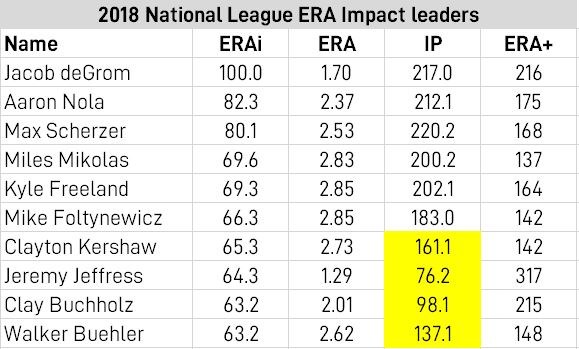
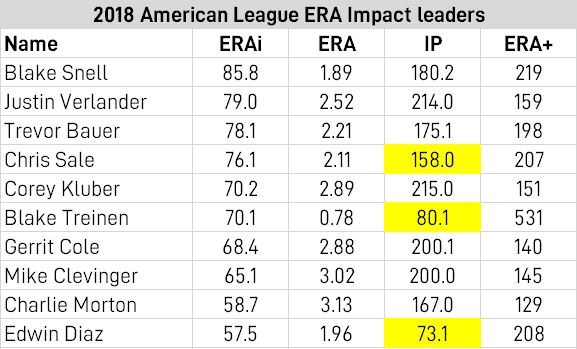
The formula removes the pitcher’s total earned runs and innings pitched from the overall MLB total and the difference in the resulting overall MLB ERA is used to calculate ERA Impact. The numbers, which are tedious negative or positive values, are characterized as a percentile, 0 to 100. The overall leader scores 100. That pitcher we get every year with a 6.50 ERA in 140 innings? Yeah, he’s the zero.
ERA Impact = ((lER-pER)*9/(lIP-pIP))-lERA
p – pitcher l – league
What got me thinking about this: In 2017, the Pirates’ Chad Kuhl didn’t miss a start and still didn’t qualify for the ERA title. Same with Wade Miley of the Orioles. He made 32 starts that year and was disallowed from being a factor. That’s a problem.
In the minors, pitchers can qualify for the ERA title having delivered an innings number equal to 80 percent of the team’s games. While MLB adjusting to that would make for an easy number to memorize as a threshold, it still eliminates relievers. And in those seasons where relievers are extraordinary, they should be eligible to be deemed a league ERA champion.
Relievers have a hard time winning the ERA title with ERA Impact, but at least they’re included. They have ranked highly in years when pitching more innings, like the late 1970s, or, when we’ve seen sub-1.00 seasons. ERA Impact also reveals the value of starters’ innings, more so, though, before they were scarce, as they are today. In this example, in 1977, ace relievers have a significant impact, and it illustrates a starting pitcher with a higher ERA can outperform another, because he affected a good deal more of his team’s season.
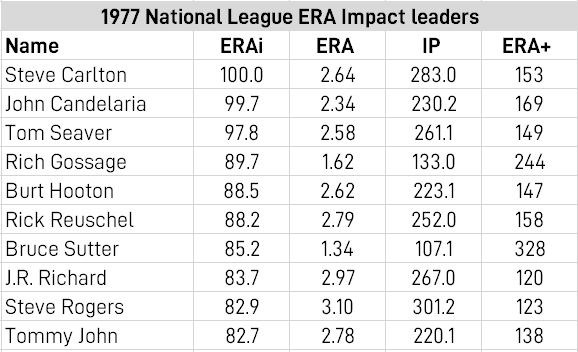
As recently as 2012, if ERA Impact was used to decide the “individual pitching champion,” there would be a non-qualifier winning. Kris Medlen used his record- breaking second half to edge Clayton Kershaw by an unbelievably slim margin. With all the capabilities we have today, this could be a race worth following year after year, especially when relievers are
involved. Should MLB retroactively strip Kershaw of the ERA title? No. I don’t think that does any good, but I do think going forward we can establish a new methodology.

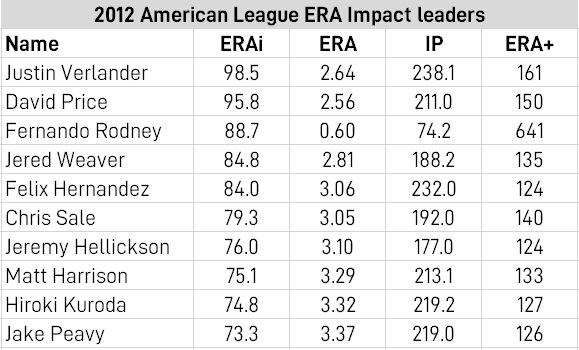
My thought behind using ERA Impact to determine the ERA leader originated from when I played fantasy baseball. I used it as a way to evaluate the impact both starters and relievers have on a team since their categorical contributions vary wildly. I wanted a firm number to quantify their value. ERA Impact, in essence, settles a real-life contribution any pitcher has on that season’s baseball-wide ERA. I contend it also improves upon ERA+ as a method for comparing ERAs through the generations since it weights innings pitched, because, after all, the more one pitches effectively, the greater contribution one has on his team and, truly, the greater a performance it is.
ERA Impact could also be used in arbitration hearings and in free agent negotiations, just as effectively as a barroom debate. Front offices strive to calculate the value of a win and a player’s contribution to one. So what is the value of a reliever in today’s pitching landscape? ERA Impact helps define it much more effectively than, say, saves.
In the 1930s, regular pitchers were defined as having pitched at least 10 complete games. No team had more than five in 2018. The way we rate pitchers is ever-evolving.
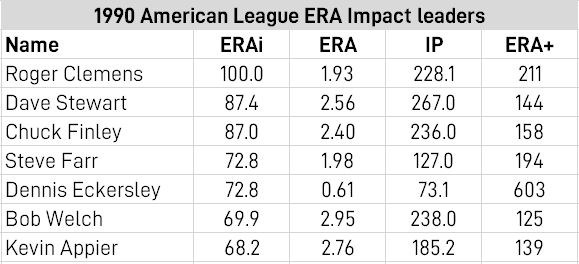
Look at 1990. Steve Farr, as a swingman, offered 127 innings. Starters easily topped 220 innings. Ninety pitchers (on the 26 teams) qualified for the 162-inning threshold. It worked then. But it doesn’t compute today and it won’t work going forward.
ERA Impact should be incorporated as the official method for determining the ERA champion going forward, even if only the nostalgic are still interested.
This article was originally written in October, 2018.
Copyright 1998-2020 – 12 Mile Media Corp. All Rights Reserved.


